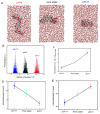Revealing the Control Mechanisms of pH on the Solution Properties of Chitin via Single-Molecule Studies
- PMID: 37836611
- PMCID: PMC10574145
- DOI: 10.3390/molecules28196769
Revealing the Control Mechanisms of pH on the Solution Properties of Chitin via Single-Molecule Studies
Abstract
Chitin is one of the most common polysaccharides and is abundant in the cell walls of fungi and the shells of insects and aquatic organisms as a skeleton. The mechanism of how chitin responds to pH is essential to the precise control of brewing and the design of smart chitin materials. However, this molecular mechanism remains a mystery. Results from single-molecule studies, including single-molecule force spectroscopy (SMFS), AFM imaging, and molecular dynamic (MD) simulations, have shown that the mechanical and conformational behaviors of chitin molecules show surprising pH responsiveness. This can be compared with how, in natural aqueous solutions, chitin tends to form a more relaxed spreading conformation and show considerable elasticity under low stretching forces in acidic conditions. However, its molecular chain collapses into a rigid globule in alkaline solutions. The results show that the chain state of chitin can be regulated by the proportions of inter- and intramolecular H-bonds, which are determined via the number of water bridges on the chain under different pH values. This basic study may be helpful for understanding the cellular activities of fungi under pH stress and the design of chitin-based drug carriers.
Keywords: chitin; elasticity; molecular dynamic simulations; non-covalent interactions; single-molecule force spectroscopy.
Conflict of interest statement
The authors declare no conflict of interest.
Figures






Similar articles
-
Effect of Environmental pH on the Mechanics of Chitin and Chitosan: A Single-Molecule Study.Polymers (Basel). 2024 Apr 5;16(7):995. doi: 10.3390/polym16070995. Polymers (Basel). 2024. PMID: 38611253 Free PMC article.
-
Effects of hydrogen bonds on the single-chain mechanics of chitin.Phys Chem Chem Phys. 2022 Oct 12;24(39):24535-24541. doi: 10.1039/d2cp02907c. Phys Chem Chem Phys. 2022. PMID: 36193805
-
Predicting the molecular shape of polysaccharides from dynamic interactions with water.Glycobiology. 2003 Apr;13(4):255-64. doi: 10.1093/glycob/cwg031. Epub 2002 Dec 17. Glycobiology. 2003. PMID: 12626381
-
Stretching single polysaccharides and proteins using atomic force microscopy.Chem Soc Rev. 2012 May 7;41(9):3523-34. doi: 10.1039/c2cs15329g. Epub 2012 Feb 13. Chem Soc Rev. 2012. PMID: 22331199 Review.
-
Interrogation of single synthetic polymer chains and polysaccharides by AFM-based force spectroscopy.Chemphyschem. 2007 Nov 12;8(16):2290-307. doi: 10.1002/cphc.200700175. Chemphyschem. 2007. PMID: 17847140 Review.
Cited by
-
Effect of Environmental pH on the Mechanics of Chitin and Chitosan: A Single-Molecule Study.Polymers (Basel). 2024 Apr 5;16(7):995. doi: 10.3390/polym16070995. Polymers (Basel). 2024. PMID: 38611253 Free PMC article.
References
MeSH terms
Substances
Grants and funding
LinkOut - more resources
Full Text Sources
Miscellaneous

